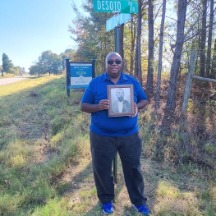

We discovered this commonality when I posted about it on Facebook and visited the land where enslavers forced some of my ancestors to live and work. After seeing the posting, he contacted me, offered research assistance, and shared his story.
Enslavers held our fore-parents captive about 23 miles apart in northwestern Mississippi, just south of Memphis. Ironically, Ryan and I grew up about 24 miles apart in the Calumet region—his parents raised him on Chicago's Great South Side and mine around Lake Michigan in the City of Gary.
The Chickasaws have an interesting history with Africans and Europeans. After the American Revolutionary War, the Tories, loyal to the King of England, left the East Coast and moved to British-claimed territories, including the Chickasaw Nation.
The Tories intermarried with the Chickasaw, raised cotton, and enslaved Africans. The interracial Loves were among the most prominent families; their descendants own Love's Travel Stops.
Since they enslaved people, the Europeans called the Chickasaw a "civilized tribe." There were five such southeastern nations.
However, owning land was not a concept in the Chickasaw mind. So, to pay the Native Americans for their land, the Europeans assigned them property and determined its value. Henry Loverman, who was half Cherokee, helped facilitate the sales between the Europeans and the indigenous people. By 1850, The Chickasaw had ceded their lands in Mississippi and moved to Oklahoma.
In 1854, when Ryan's second great-grandfather Henry was about five, European-American Graves Pennington had moved from Nashville, Tennessee, to Hudsonville, Marshall County, Mississippi, and transferred his ownership of Henry to his son William R. Pennington. William R. Pennington died in 1854 in Holly Springs, the county seat of Marshall County.
By 1860, Thomas Duty was another of the new White owners in the former Chickasaw nation. He, too, moved from Tennessee, Williamson County in particular, which ironically is about 23 miles from Nashville.
Duty owned my third great-grandparents, James (Henry) and Mary. He "only" owned 17 enslaved persons in Barton, Marshall County, Mississippi. His holdings were small compared to the largest holder of human property, Welden Jones, who owned 223 Africans.
Director of the Marshall County Historical Museum Jim Moore's research shows that Marshall County's slaveholdings did not follow the often repeated narrative that only a small number of White residents had enslaved Africans. The 1860 Census indicates that Marshall County had 17,526 enslaved people and only 11,384 Whites. There were 1,303 enslavers, all male, of course.
While we are unsure how many White households were in the county, assuming that the average White household had five people, the county had about 2,227 white households (11,384/5). These numbers mean that about 57 percent of the households (1,303/2,277) owned at least one enslaved person.
.
When the American Civil War ended in 1866, the question for Europeans and Africans was, "What's next?" Neither of our ancestors moved away immediately or distanced themselves from their former owners.
Henry took the Pennington name as his own and started a family. He was on the Marshall County, Mississippi, census in 1870, five years after the Thirteenth Amendment freed Africans from bondage.
The 1870 Census also lists Henry and Mary Duty in the same county. They lived next door to their former master's youngest sons, Matthew and John W. Duty. The boys inherited part of their daddy's land. Other nearby Duty households included Henry and Mary's children and grandchildren.
Sharecropping was "one way of existing," says Moore. Tenant farming was a step up. Sharecroppers shared a percentage of their crops with the landlord, whereas tenant farmers paid the landlords rent and kept the proceeds from the farm.
With sharecropping, the landlord supplied the sharecropper with everything from seeds to groceries, and with the freedpeople not owning anything and being unable to read or write, this was often the only opportunity for them. Sharecropping was "just a step up from the slavery system, with an avenue to leave," added Moore. Neither Ryan nor I am sure of the arrangement our ancestors had with their former owners.
Our foreparents also have similar Great Black Migration stories. By 1952, Ryan's father moved from Turrell, Crittenden Country, Arkansas, north to Chicago with the help of a friend. He met Ryan's mother in Chicago.
My parents were born and raised 56 miles away in Forrest City, St. Francis County, Arkansas. They were married when they moved north to Gary in 1951, a year before Ryan's father moved north. They had relatives in Chicago but settled with the assistance of relatives in nearby Gary.
Facebook can be a mindless toy. However, it can also bring together spirits who seem to have been "following" and "ghosting" each other for centuries.
Note: Young got research assistance from genealogist Paul Heinegg.






